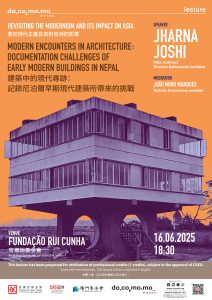Encontros Modernos na Arquitetura – 2025.06.16
O Centro de Investigação DOCOMOMO Macau tem o prazer de o(a) convidar para a palestra “Encontros Modernos na Arquitetura: Desafios de Documentação de Edifícios Modernistas no Nepal”.
Junte-se a nós para uma conferencia com a oradora convidada Prof.ª Arquiteta Jharna Joshi, numa conversa moderada pelo Arquiteto João Nuno Marques, no dia 16 de junho de 2025, às 18h30.
O evento terá lugar na Fundação Rui Cunha, situada na Avenida da Praia Grande, nº 749, r/ch, Macau.
Jharna Joshi é arquiteta (Universidade de Tsinghua, Pequim), com especializações em conservação histórica (Universidade da Pensilvânia, EUA) e paisagens culturais (Universidade Jean Monnet, França). Concluiu recentemente um doutoramento em Gestão (Turismo) na Victoria University of Wellington, Nova Zelândia. A sua dissertação, Estética da Paisagem, Turismo e Mudança: Estudos de Caso no Nepal, analisa como residentes e turistas percebem as mudanças estéticas da paisagem em Ghandruk, Bandipur e Sauraha.
Com mais de vinte anos de experiência em arquitetura, conservação, paisagens culturais, turismo e ensino, Jharna trabalhou no Nepal, China, Hong Kong, EUA, Vietname, Grécia e Nova Zelândia. Liderou projetos de restauro e reutilização adaptativa em todo o Nepal, com ênfase em materiais locais, saberes tradicionais e reutilização criativa. Colabora com profissionais nacionais e internacionais em projetos de arquitetura e conservação do património, e leciona como docente convidada, com foco na conservação urbana, arquitetura vernacular, povoamentos e paisagens culturais.
“Encontros modernos na arquitetura: Desafios de documentação de edifícios modernistas no Nepal”
No Nepal, o discurso arquitetónico tem-se centrado sobretudo nos edifícios patrimoniais, que precisam de ter pelo menos cem anos para obter reconhecimento oficial. Como consequência, a arquitetura moderna inicial — estruturas construídas entre 1945 e 1985 — permanece desvalorizada, não documentada e vulnerável à demolição ou ao abandono. A ausência de uma tradição consolidada de arquivamento de materiais arquitetónicos dificulta ainda mais a compreensão e o ensino deste período, deixando estudantes e docentes com poucos recursos.
A recente iniciativa do Instituto de Kathmandu para documentar edifícios modernos iniciais evidenciou esta lacuna. Estas construções simbolizavam o impulso de modernização do Nepal, transformando zonas agrícolas em espaços urbanos. No entanto, o desenvolvimento acelerado e a comercialização colocaram-nas em risco de desaparecer. A recolha de documentação revelou-se difícil, devido à escassez de arquivos e à diversidade de formatos — desde esboços a lápis e plantas até diapositivos e fotografias — obtidos de coleções privadas, instituições e arquivos online.
Esta palestra apresenta as conclusões iniciais do projeto, com o objetivo de promover o diálogo e a valorização desta era negligenciada da arquitetura nepalesa. Para além da preservação histórica, o projeto tem também uma vertente educativa e de sensibilização pública, lançando as bases para futuras iniciativas de proteção legal e investigação contínua.

























Deixar uma resposta
Tem de ter a sessão iniciada para publicar um comentário.